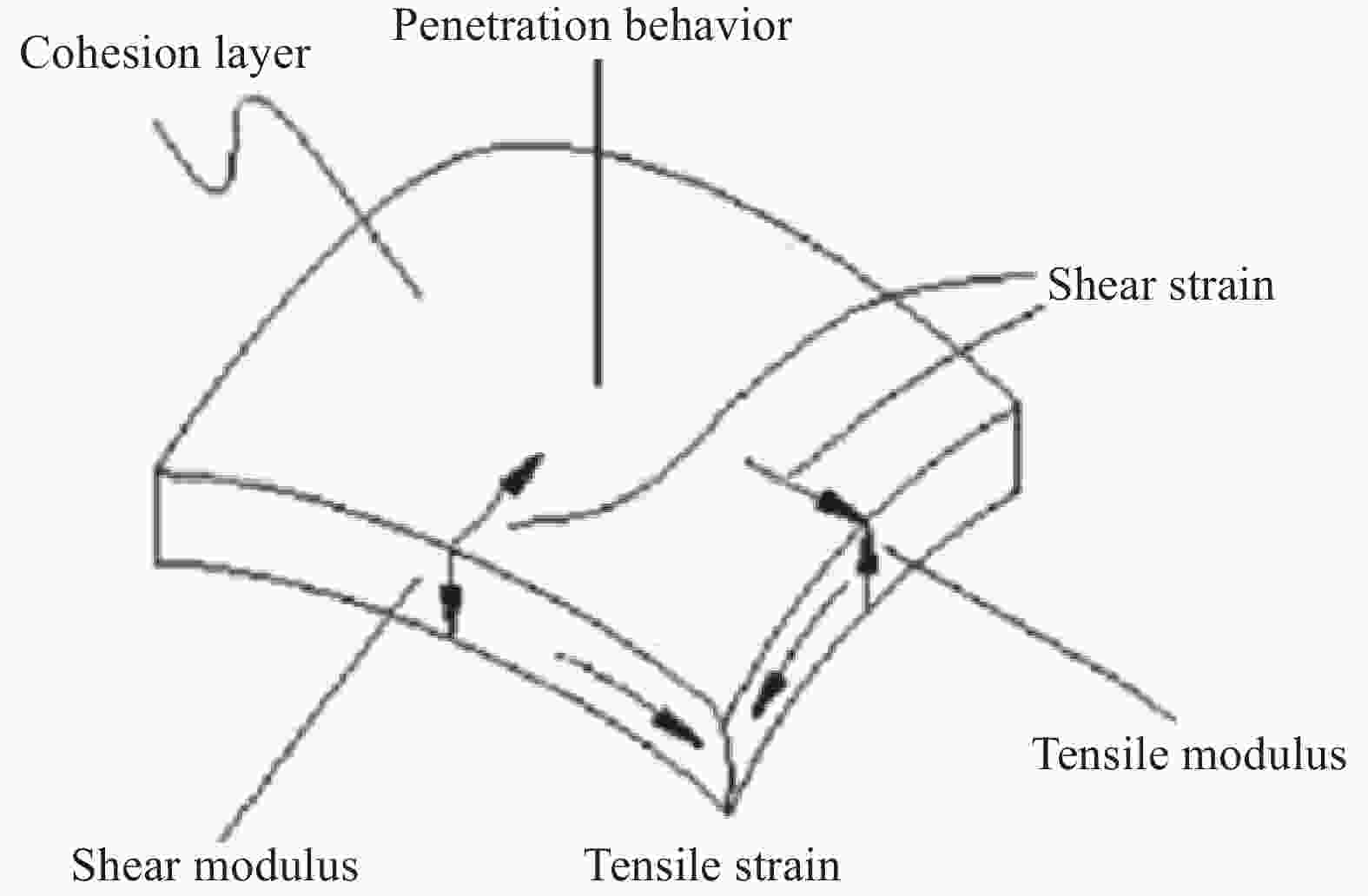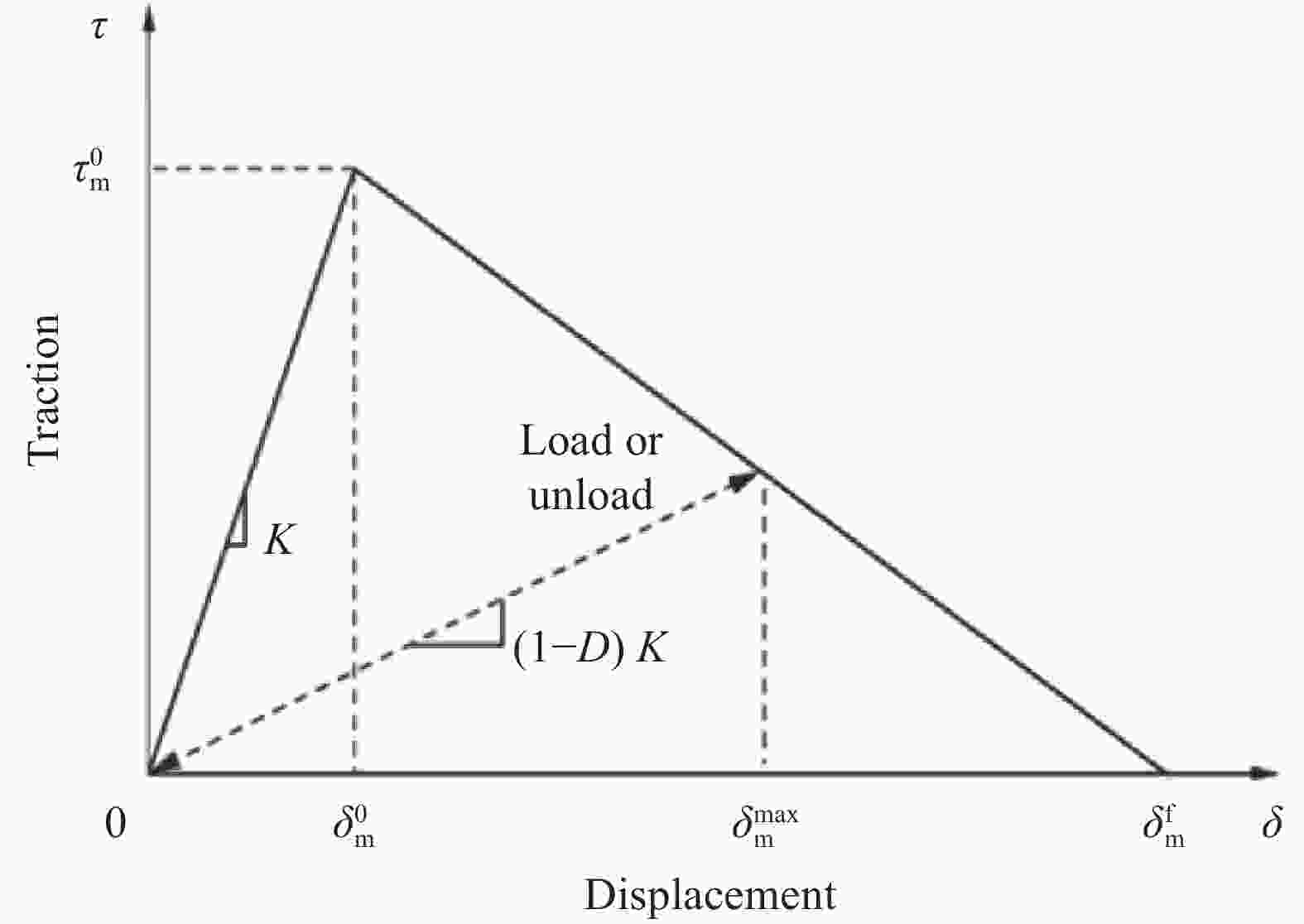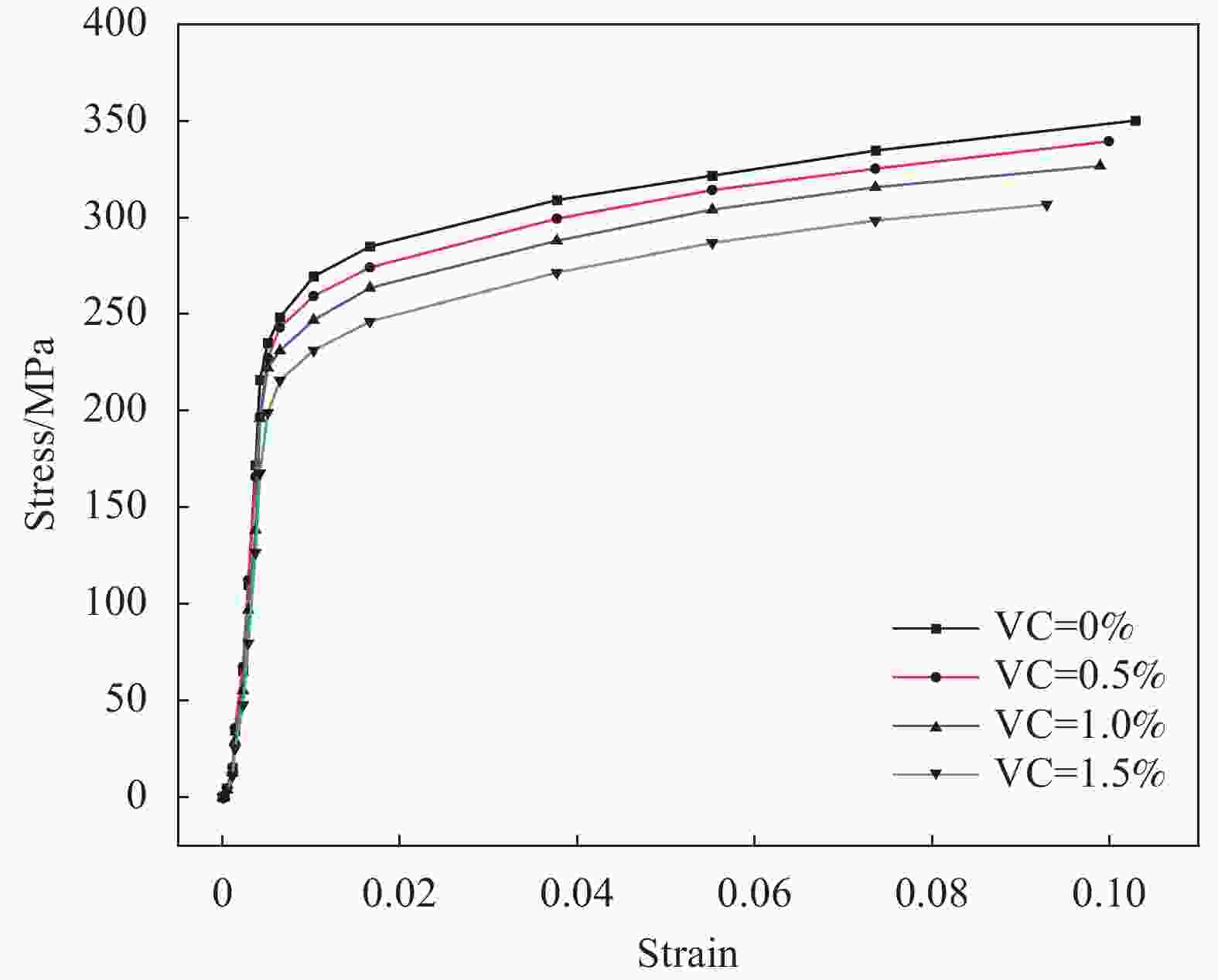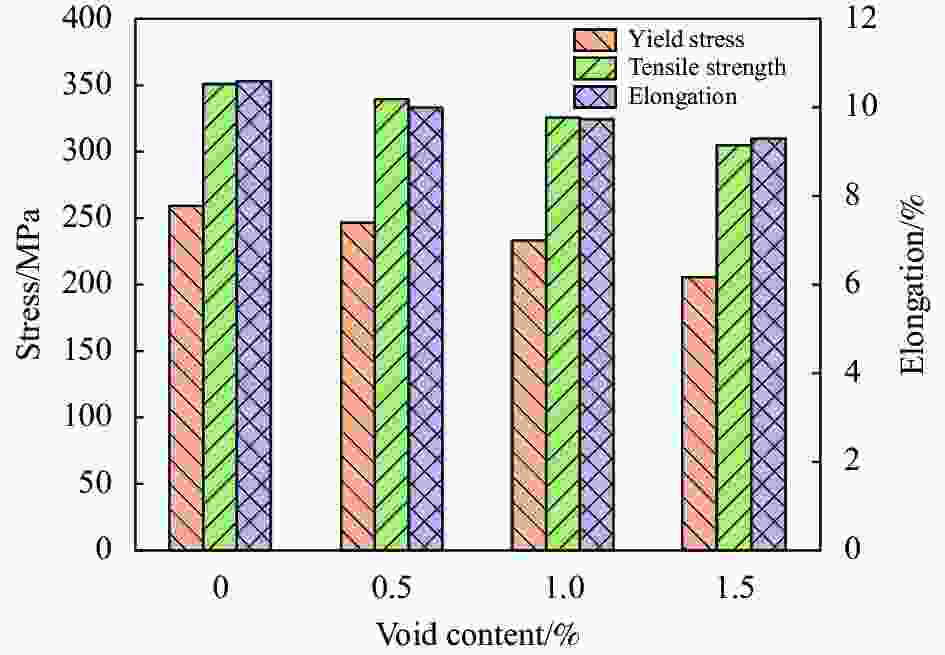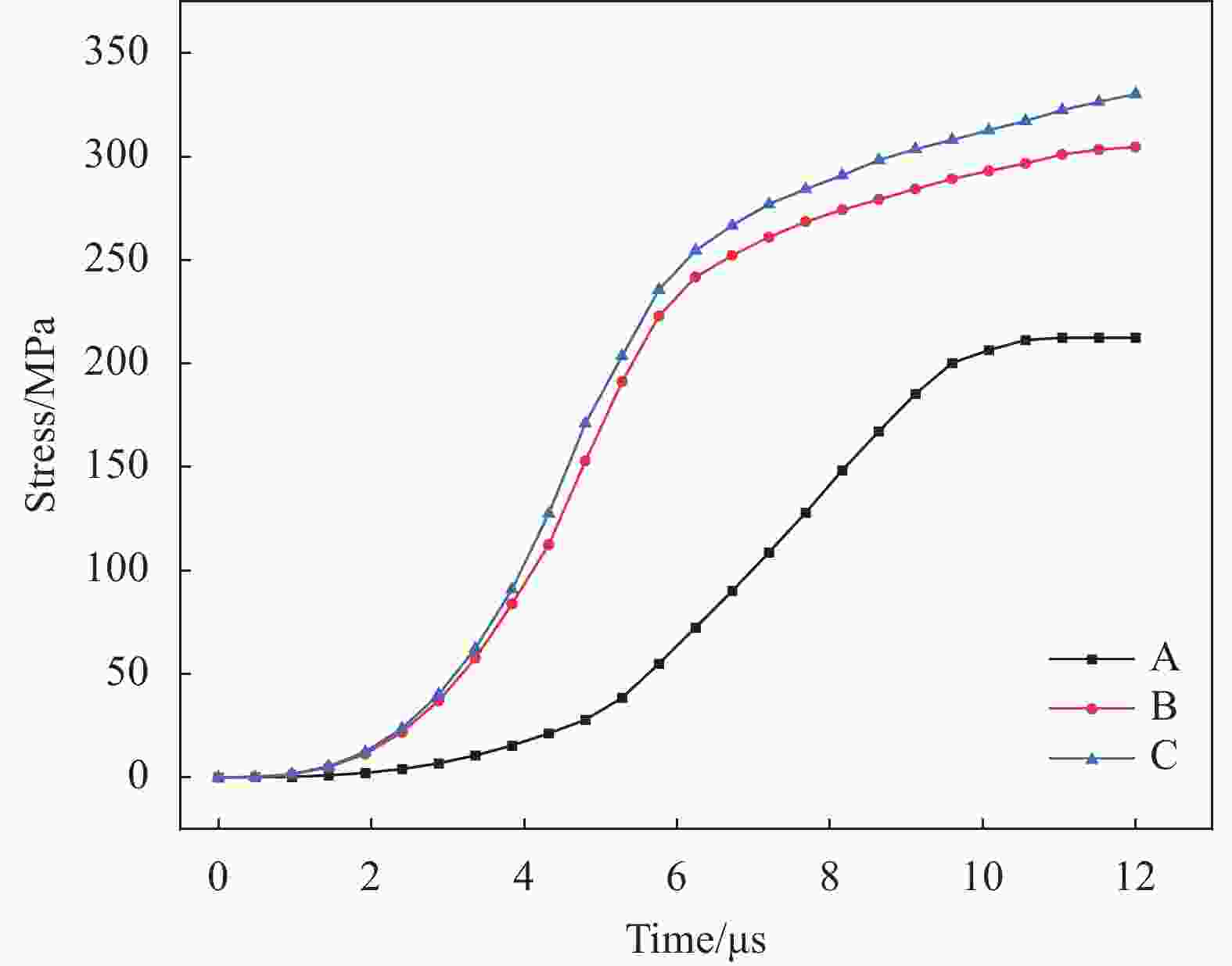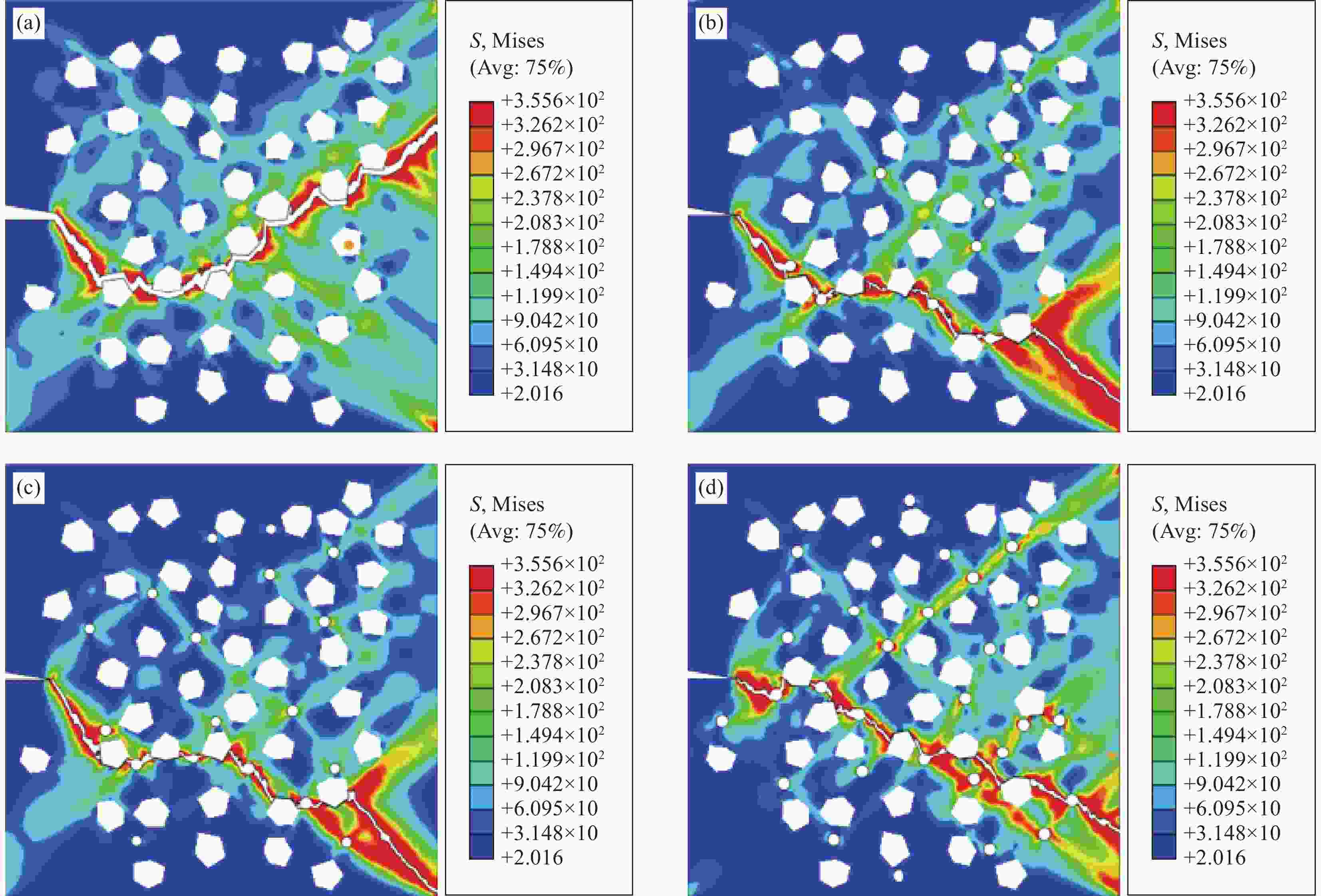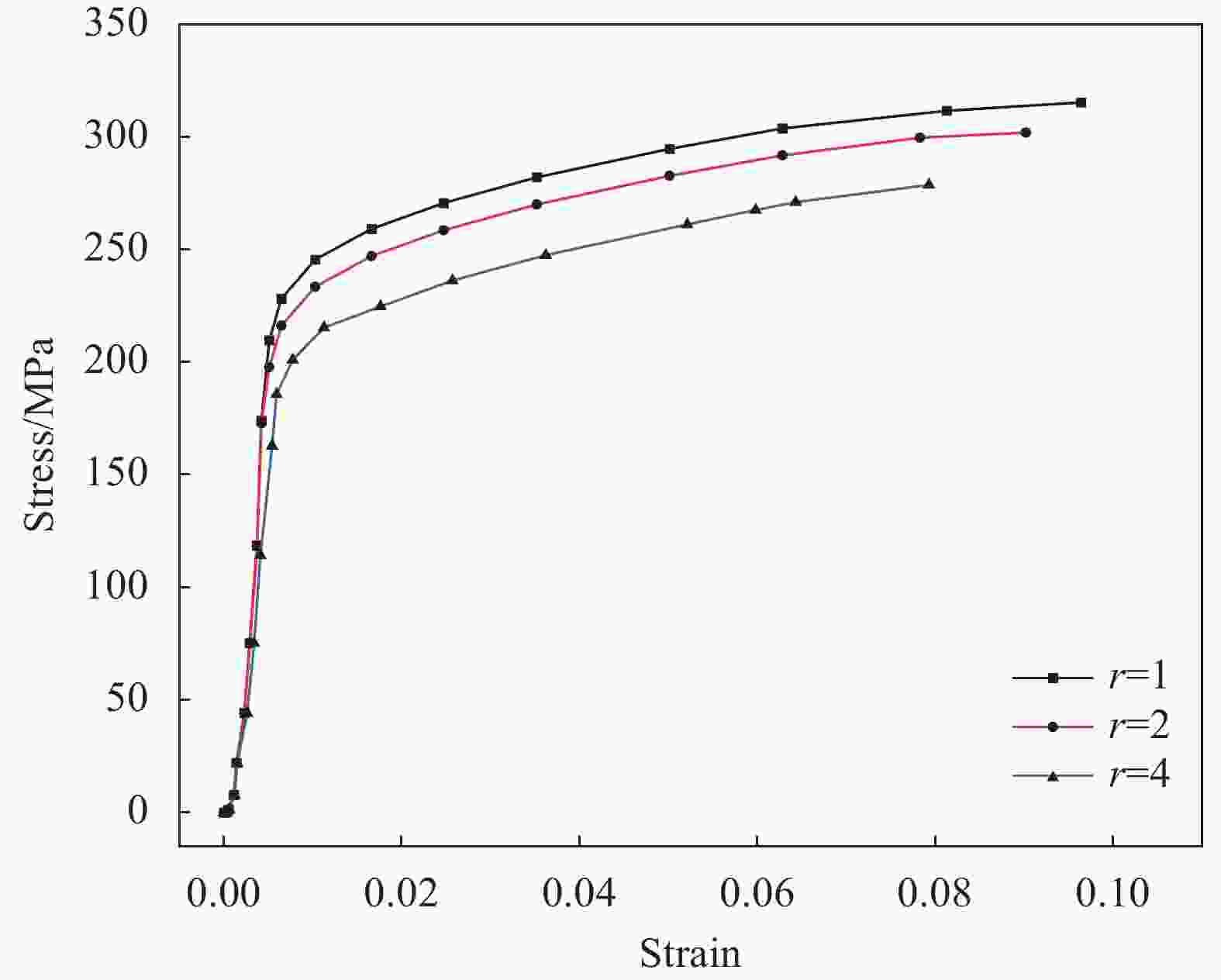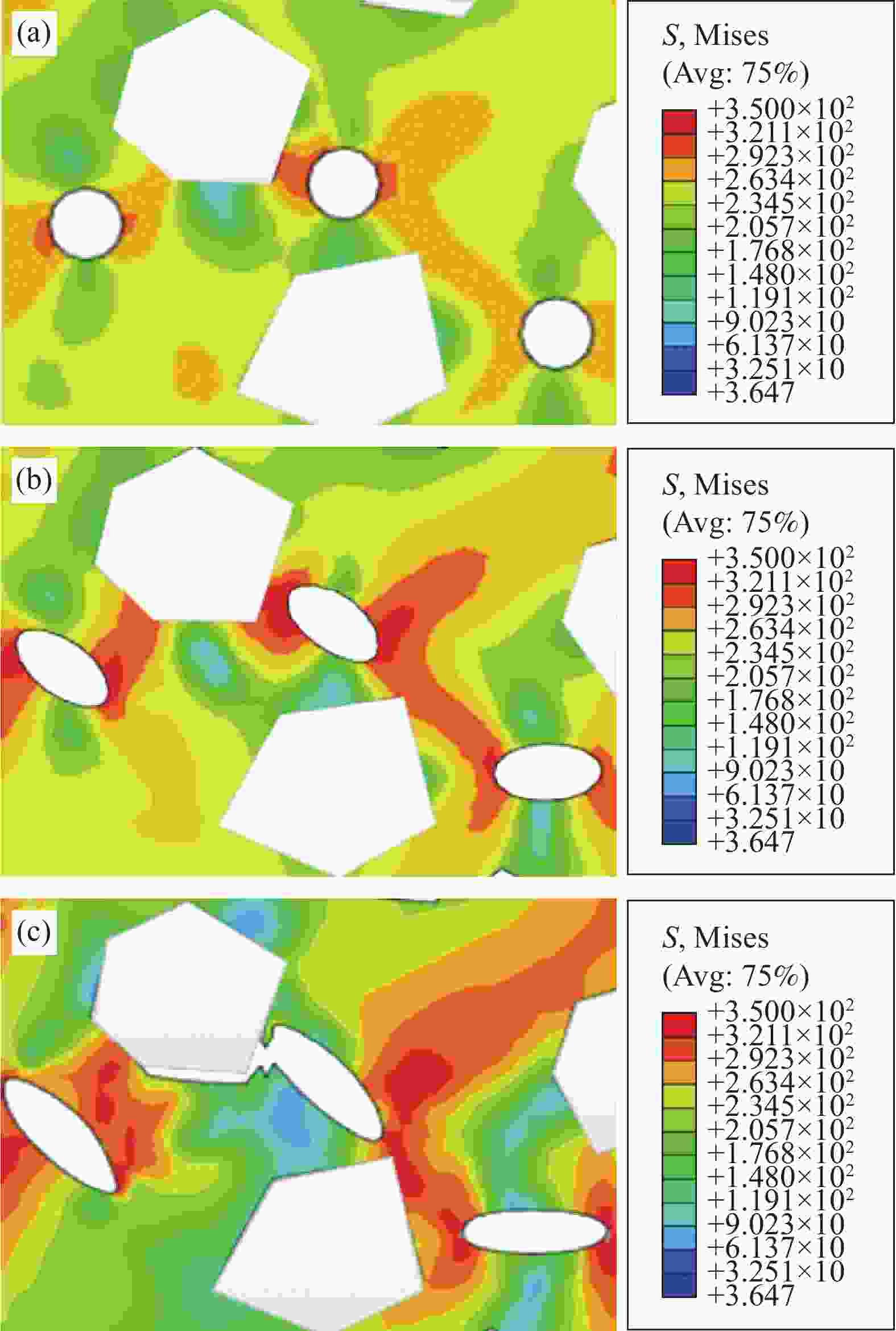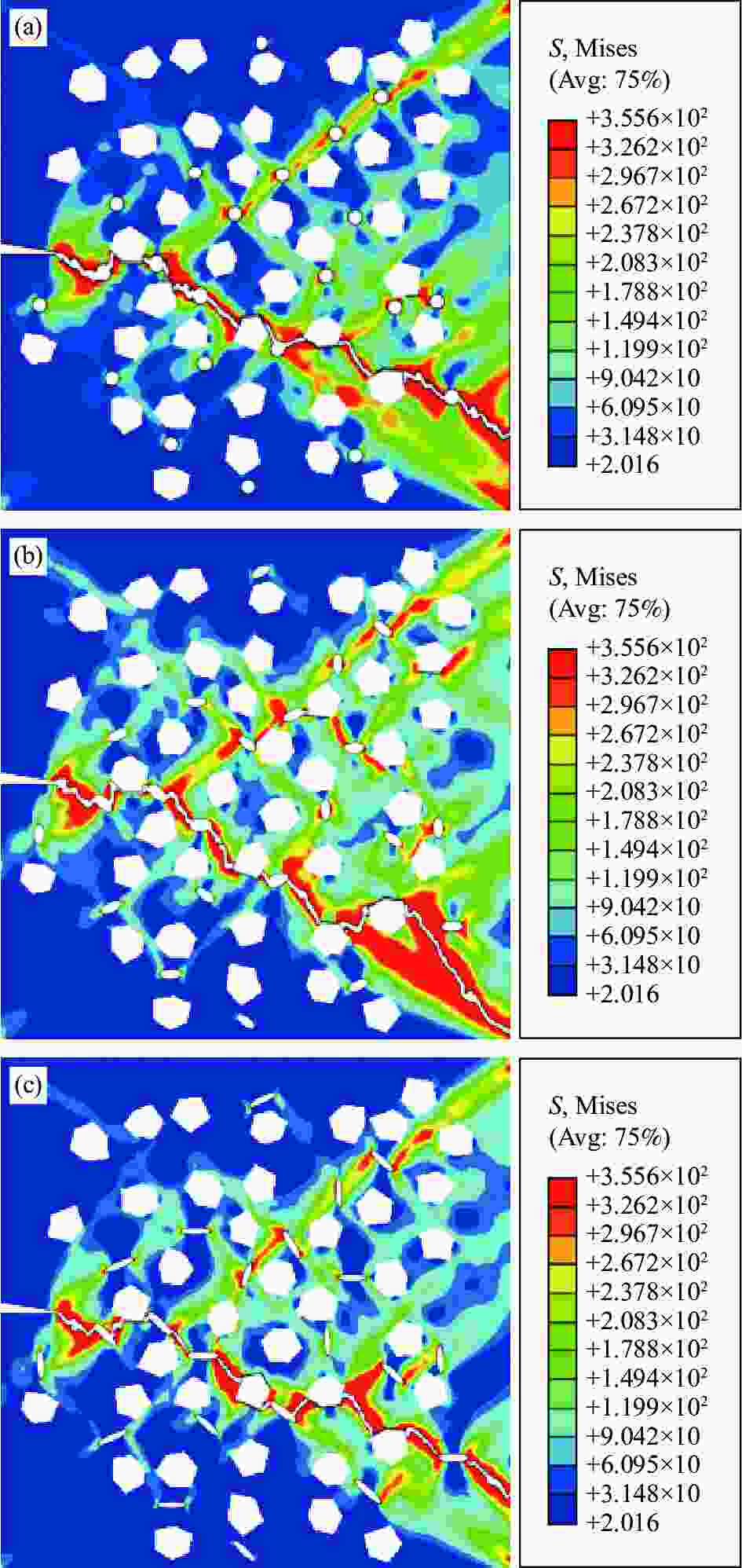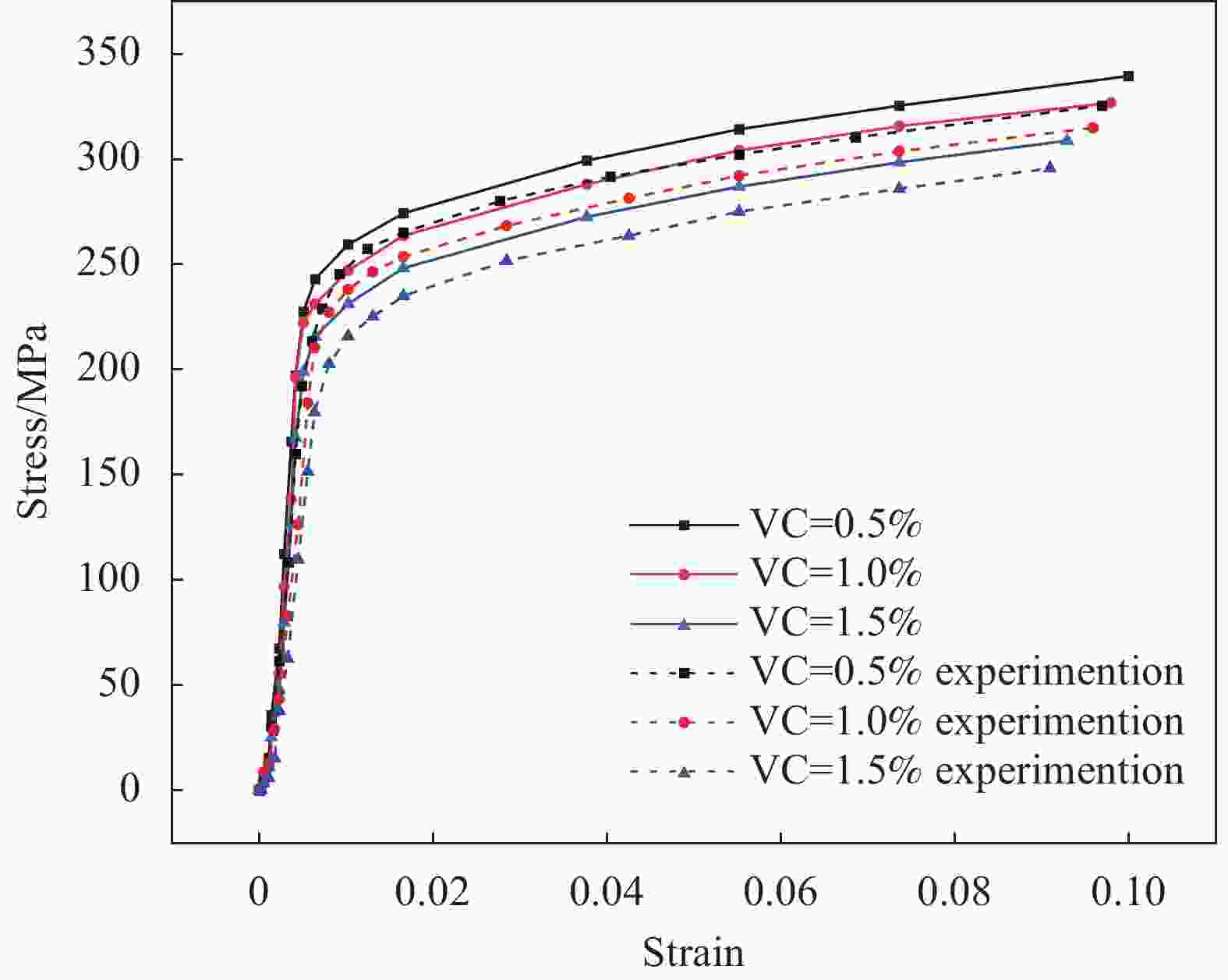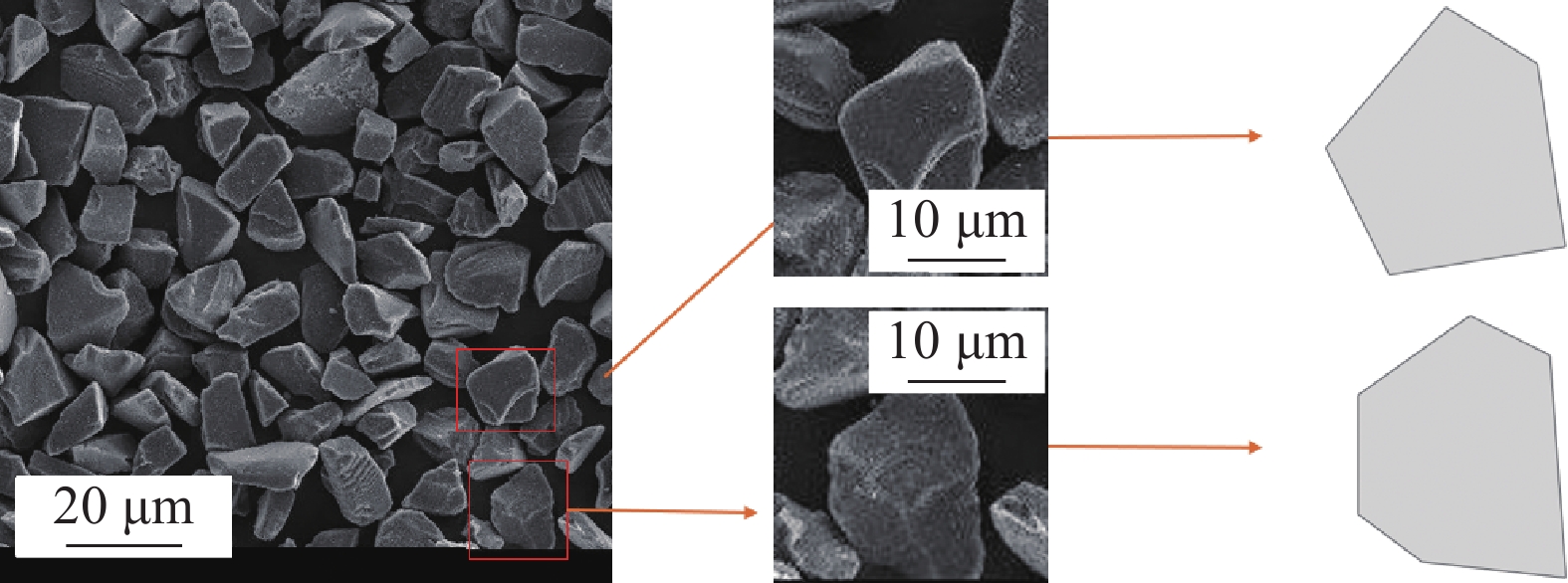Effect of porosity defects on crack initiation and propagation behavior in SiC/AZ91D composites
-
摘要: 采用内聚力模型及有限元分析方法,在含真实形貌SiC颗粒增强AZ91D镁基复合材料中引入孔隙缺陷,分析不同孔隙率及孔隙形状在单轴拉伸过程中对SiC/AZ91D复合材料力学行为的影响。结果表明:孔隙长径比为1时,孔隙率为0%、0.5%、1.0%、1.5%的复合材料的抗拉强度分别为351.214 MPa、339.452 MPa、325.735 MPa、306.791 MPa,抗拉强度随孔隙率的增加逐渐降低,复合材料中裂纹萌生和裂纹扩展时间均随孔隙率增加而提前。孔隙长径比越大,其尖端部位应力集中越严重,复合材料抗拉强度也越低。无孔隙缺陷的SiC/AZ91D复合材料裂纹萌生扩展机制是颗粒与基体交界处萌生微裂纹,微裂纹相互连接形成主裂纹绕开颗粒进行扩展致使材料断裂,含孔隙的SiC/AZ91D复合材料裂纹萌生扩展机制为微裂纹在孔隙周围萌生,与颗粒和基体交界处产生的微裂纹相互连接,汇集成主裂纹绕开颗粒扩展使材料断裂。Abstract: Using the finite element analysis method, this study introduced porosity defects into SiC/AZ91D magnesium matrix composites with realistic SiC particle morphology, and analyzed the influence of different porosity rates and shapes on the mechanical behavior of SiC/AZ91D composites during uniaxial tensile process. The results show that when the aspect ratio of the pore length to width is 1, the tensile strengths of the composites with void contents of 0%, 0.5%, 1.0%, and 1.5% are 351.214 MPa, 339.452 MPa, 325.735 MPa and 306.791 MPa, respectively. The tensile strength gradually decreases with the increase of porosity rate, and the initiation and propagation time of cracks in the composite material advances with the increase of porosity rate. As the aspect ratio of the pore length to width increases, the stress concentration at the tip of the pore becomes more severe, resulting in lower tensile strength of the composite material. The crack initiation and propagation mechanism in the SiC/AZ91D composite material without porosity defects involves the initiation of microcracks at the particle-matrix interface, followed by their interconnection to form a main crack, which propagates around the particles leading to material fracture. In the case of SiC/AZ91D composites with porosity, microcracks initiate around the pores and interconnect with microcracks generates at the particle-matrix interface, ultimately converging into a main crack that propagates around the particles, causing material fracture.
-
Key words:
- SiC/AZ91D composites /
- crack initiation /
- crack extension /
- finite element analysis /
- porosity /
- cohesive model
-
图 6 双线性内聚力模型
Figure 6. Bilinear cohesive zone model
$ {\delta }_{\mathrm{m}}^{\text{max}} $—Maximum value of the effective displacement; $ {\delta }_{\mathrm{m}}^{\mathrm{f}} $—Effective displacement at complete failure; $ {\delta }_{\mathrm{m}}^{0} $—Effective displacement at the initiation of damage; $ {\tau }_{\mathrm{m}}^{0} $—Maximum separation stress; K—Elasticity coefficient or spring constant; D—Damage amount
表 1 排水法测量的SiC/AZ91D复合材料孔隙率(VC)
Table 1. Void content (VC) measurement for SiC/AZ91D composite material using drainage method
Sample serial number VC/% 1 1.56 2 0.84 3 0.85 4 1.62 5 0.83 6 0.41 7 1.65 8 0.94 9 0.48 10 1.18 表 2 AZ91D镁合金和SiC颗粒的基本参数
Table 2. Basic parameters of AZ91D magnesium alloy and SiC particles
Material $ \rho $/(kg·m−3) E/GPa $ \mu $ σb/MPa AZ91D 1800 45 0.33 164 SiC 3215 450 0.17 2000 Notes: $ \rho $—Material density; E—Modulus of elasticity; $ \mu $—Poisson's ratio; σb—Tensile strength. 表 3 SiC/AZ91D颗粒-界面的本构模型参数
Table 3. Constitutive model parameters of SiC/AZ91D particle-interface
$ {t}_{\mathrm{n}}/\mathrm{M}\mathrm{P}\mathrm{a} $ $ {t}_{\mathrm{t}}/\mathrm{M}\mathrm{P}\mathrm{a} $ $ {\delta }_{\mathrm{m}\mathrm{a}\mathrm{x}}/\mathrm{m}\mathrm{m} $ $ {\delta }_{\mathrm{f}}/\mathrm{m}\mathrm{m} $ 400 400 0.00015 0.00005 Notes: $ {t}_{\mathrm{n}} $—Interface normal nominal stress; $ {t}_{\mathrm{t}} $—Interfacial tangential nominal stress; $ {\delta }_{\mathrm{m}\mathrm{a}\mathrm{x}} $—Destruction displacement; $ {\delta }_{\mathrm{f}} $—Material complete failure separation. 表 4 AZ91D镁合金的Johnson-Cook (J-C)本构参数
Table 4. Johnson-Cook (J-C) constitutive model parameters for AZ9ID magnesium alloy
A/MPa B/MPa n C ${u}_{{\rm{f}}}^{\mathrm{p}\mathrm{l} }/{\rm{mm} }$ 164 600 0.283 0.021 0.00015 Notes: A—Yield strength of AZ91D matrix under static load; B—Hardening constant; n—Hardening exponent; C—Strain rate constant; $ {u}_{\mathrm{f}}^{\mathrm{p}\mathrm{l}} $—Failure displacement. 表 5 SiC颗粒本构模型及失效参数
Table 5. Constitutive model and failure parameters of SiC particles
Parameter Value G/GPa 193 A0 0.96 B0 0.35 C0 0.009 M 1 N 0.65 T1/MPa 750 SFMAX/MPa 1300 LHE/MPa 11700 PHEL/MPa 5130 D1 0.48 D2 0.48 K1 220000 K2 361000 K3 0 Notes: G—Shear modulus; A0—Strength parameter before damage; B0—Strength parameter when damage occurs; C0—Strain rate constant; M—Pressure index when damage occurs; N—Pressure index when no damage occurs; T1—Cut-off pressure; SFMAX—Maximum fracture strength; LHE—Hugoniot elastic limit; PHEL—Hugoniot elastic limit pressure; D1, D2—Fracture constant; K1, K2, K3—Material parameter. -
[1] 褚兵强. 低能量冲击对含孔隙CFRP层合板力学性能的影响研究[D]. 哈尔滨: 哈尔滨工业大学, 2011.CHU Bingqiang. The effects of low-energy impact on the mechanical properties of carbon fiber reinforced polymer laminates with voids[D]. Harbin: Harbin Institute of Technology, 2011(in Chinese). [2] 李钊. 碳纤维复合材料孔隙率超声检测与评价技术研究[D]. 杭州: 浙江大学, 2014.LI Zhao. Research on ultrasonic detection and evaluation technique for porosity of carbon fiber composites[D]. Hangzhou: Zhejiang University, 2014(in Chinese). [3] 李亚星, 李洪双, 陈普会. 考虑孔隙随机性的SiC/SiC复合材料力学性能参数概率分析[J/OL]. 应用力学学报: 1-12[2024-01-08].LI Yaxing, LI Hongshuang, CHEN Puhui. Probability analysis of mechanical properties parameters of SiC/SiC composites considering pore randomness[J/OL]. Chinese Journal of Applied Mechanics: 1-12[2024-01-08](in Chinese). [4] HONG Y, WANG W J, LIU J Q, et al. Effect of porosity and interface structures on thermal and mechanical properties of SiCp/6061Al composites with high volume fraction of SiC[J]. Transactions of Nonferrous Metals Society of China,2019,29(5):941-949. doi: 10.1016/S1003-6326(19)65003-X [5] GAO M Q, GUO E Y, CHEN Z N, et al. Revealing the role of micropore defects in tensile deformation of a B4Cp/Al composite using an actual three-dimensional model[J]. Journal of Materials Research and Technology,2023,22:3146-3155. doi: 10.1016/j.jmrt.2022.12.145 [6] CHAMBERS A R, EARL J S, SQUIRES C A, et al. The effect of voids on the flexural fatigue performance of unidirectional carbon fibre composites developed for wind turbine applications[J]. International Journal of Fatigue,2006,28(10):1389-1398. doi: 10.1016/j.ijfatigue.2006.02.033 [7] KOSMANN N, KARSTEN J M, SCHUETT M, et al. Determining the effect of voids in GFRP on the damage behaviour under compression loading using acoustic emission[J]. Composites Part B: Engineering,2015,70:184-188. [8] 张阿樱. 孔隙率对碳纤维/环氧树脂层压板力学性能的影响[J]. 中国机械工程, 2010, 21(24):3014-3018.ZHANG A'ying. Experimental characterization of porosity and mechanical properties of carbon/epoxy composite laminates[J]. China Mechanical Engineering,2010,21(24):3014-3018(in Chinese). [9] 张阿樱, 张东兴. 不同孔隙率 CFRP 层合板冲击后力学性能试验表征[J]. 材料科学与工艺, 2014, 46(3): 54-60.ZHANG A'ying, ZHANG Dongxing. Research on the static mechanical properties of CFRP laminates with different void contents[J]. Materials Science and Technology, 2014, 46(3): 54-60(in Chinese). [10] RICOTTA M, QUARESIMIN M, TALREJA R. Mode I strain energy release rate in composite laminates in the presence of voids[J]. Composites Science and Technology,2008,68(13):2616-2623. doi: 10.1016/j.compscitech.2008.04.028 [11] SUO Y Y, WANG B, JIA P R, et al. The effect of fabrication defects on the mechanical behaviors of metal matrix composites[J]. Materialstoday Communications,2022,25:101663. doi: 10.1016/j.mtcomm.2020.101663 [12] 乔海燕, 任学冬, 史亦韦, 等. GH4169高温合金涡轮盘表面径轴向裂纹的渗透检测可行性[J]. 航空材料学报, 2016, 36(6):92-96. doi: 10.11868/j.issn.1005-5053.2016.6.015QIAO Haiyan, REN Xuedong, SHI Yiwei, et al. Feasibility of penetrant detection of radial and axial cracks on the surface of GH4169 superalloy turbine disk[J]. Journal of Aeronautical Materials,2016,36(6):92-96(in Chinese). doi: 10.11868/j.issn.1005-5053.2016.6.015 [13] 李灼华. 射线检测在复合材料无损检测中的应用[J]. 科技传播, 2014, 6(3): 179, 175.LI Zhuohua. Application of radiographic testing in nondestructive testing of composite materials[J]. Science and Technology Communication, 2014, 6(3): 179, 175(in Chinese). [14] 陈文玮. 超声检测技术在金属材料焊接成型中的应用[J]. 山西冶金, 2022, 45(3):264-265. doi: 10.16525/j.cnki.cn14-1167/tf.2022.03.108CHEN Wenwei. Application of ultrasonic testing technology in welding and forming of metal materials[J]. Shanxi Metallurgy,2022,45(3):264-265(in Chinese). doi: 10.16525/j.cnki.cn14-1167/tf.2022.03.108 [15] 孟祥姝, 李武胜. 单向复合材料孔隙率测试技术与分布规律研究[J]. 高科技纤维与应用, 2021, 46(4):52-55. doi: 10.3969/j.issn.1007-9815.2021.04.008MENG Xiangshu, LI Wusheng. Research on porosity testing technology and distribution law of unidirectional composite materials[J]. High-tech Fiber and Application,2021,46(4):52-55(in Chinese). doi: 10.3969/j.issn.1007-9815.2021.04.008 [16] 凌振宝, 邹得宝, 张堃, 等. 岩矿石孔隙度测量方法[J]. 吉林大学学报(地球科学版), 2011, 41(3):921-924. doi: 10.13278/j.cnki.jjuese.2011.03.032LING Zhenbao, ZOU Debao, ZHANG Kun, et al. Measuring method of rock ore porosity[J]. Journal of Jilin University (Earth Science Edition),2011,41(3):921-924(in Chinese). doi: 10.13278/j.cnki.jjuese.2011.03.032 [17] 耿昆. SiCp/Al复合材料基于微细观的有限元建模拟实[D]. 上海: 上海交通大学, 2017.GENG Kun. Finite element modeling and simulation of SiCp/Al composites based on micro view[D]. Shanghai: Shanghai Jiao Tong University, 2017(in Chinese). [18] 邱鑫. 挤压铸造SiCp/AZ91镁基复合材料的显微结构与性能[D]. 哈尔滨: 哈尔滨工业大学, 2006.QIU Xin. Microstructure and properties of squeeze cast SiCp/AZ91 magnesium matrix composites[D]. Harbin: Harbin Institute of Technology, 2006(in Chinese). [19] 王涛. 高体积分数SiCp/Al复合材料高速铣削基础研究[D]. 北京: 北京理工大学, 2015.WANG Tao. Fundamental study on high speed milling of high volume fraction SiCp/Al composite[D]. Beijing: Beijing Institute of Technoloy, 2015(in Chinese). [20] TANG J M, DENG Q C. Experiment and simulation of SiC particle-reinforced aluminum matrix composites fabricated by friction stir processing[J]. The International Journal of Advanced Manufacturing Technology,2022,122(2):895-910. doi: 10.1007/s00170-022-09967-7 [21] 张磊刚. SiCp/Mg 多级纳米复合材料的压缩断裂特性研究[D]. 成都: 西南交通大学, 2018.ZHANG Leigang. Research on compressive fracture properties of SiCp/Mg hierarchical nanocomposites[D]. Chengdu: Southwest Jiaotong University, 2018(in Chinese). [22] SU Y S, LI Z, YU Y, et al. Structural modeling and tensile simulation of graphene-reinforced metal matrix composites[J]. Science China Materials,2018,61(1):112-124. doi: 10.1007/s40843-017-9142-2 [23] 梁超群, 尧军平, 李怡然, 等. SiC/AZ91D镁基复合材料单轴压缩过程中裂纹萌生扩展机制[J]. 复合材料学报, 2023, 40(7): 4282-4293.LIANG Chaoqun, YAO Junping, LI Yiran, et al. Mechanism of crack initiation and propagation during uniaxial compression of SiC/AZ91D magnesium matrix composites[J]. Acta Materiae Compositae Sinica, 2023, 40(7): 4282-4293(in Chinese). [24] 夏聪聪. 裂纹尖端拘束对单边缺口拉伸试样裂纹扩展阻力曲线影响研究[D]. 天津: 天津大学, 2021.XIA Congcong. Research on the effect of crack tip constraint on the crack propagation resistance curve of unilateral notched tensile specimens[D]. Tianjin: Tianjin University, 2021(in Chinese). [25] ZHANG J, OUYANG Q B, GUO Q, et al. 3D microstructure-based finite element modeling of deformation and fracture of SiCp/Al composites[J]. Composites Science and Technology,2016,123:1-9. doi: 10.1016/j.compscitech.2015.11.014 [26] 魏俊磊. 颗粒增强镁基复合材料力学行为的研究[D]. 太原: 太原理工大学, 2018.WEI Junlei. Study on mechanical behavior of particle reinforced magnesium matrix composites[D]. Taiyuan: Taiyuan University of Technology, 2018(in Chinese). [27] 卢子兴. 复合材料界面的内聚力模型及其应用[J]. 固体力学学报, 2015, 36(S1):85-94. doi: 10.19636/j.cnki.cjsm42-1250/o3.2015.s1.014LU Zixing. The cohesion model of composite material interface and its application[J]. Journal of Solid Mechanics,2015,36(S1):85-94(in Chinese). doi: 10.19636/j.cnki.cjsm42-1250/o3.2015.s1.014 [28] 翁琳. 基于微观结构的颗粒增强复合材料力学性能数值分析[D]. 上海: 上海交通大学, 2015.WENG Lin. Numerical analysis of mechanical properties of particle-reinforced composites based on microstructure[D]. Shanghai: Shanghai Jiao Tong University, 2015(in Chinese). [29] 张炯, 屈展, 黄其青, 等. 基于内聚力模型的圆形夹杂与基体界面渐进脱粘分析[J]. 西安石油大学学报(自然科学版), 2014, 29(3):106-110, 12.ZHANG Jiong, QU Zhan, HUANG Qiqing, et al. Progressive debonding analysis of circular inclusion and matrix interface based on cohesion model[J]. Journal of Xi'an Shiyou University (Natural Science Edition),2014,29(3):106-110, 12(in Chinese). [30] 周圣杰. B4C/2024Al复合材料变形断裂行为研究[D]. 哈尔滨: 哈尔滨工业大学, 2020.ZHOU Shengjie. Research on deformation and fracture behavior of B4C/2024Al composites[D]. Harbin: Harbin Institute of Technology, 2020(in Chinese). [31] 周爽. 纳米增强体镁基复合材料力学性能数值模拟[D]. 沈阳: 沈阳工业大学, 2017.ZHOU Shuang. Numerical simulation of mechanical properties of nano-reinforced magnesium matrix composites[D]. Shenyang: Shenyang University of Technology, 2017(in Chinese). [32] JOHNSON G R, HOLMQUIST T J. An improved computational constitutive model for brittle materials[J]. AIP Conference Proceedings, 1994, 309(1): 981-984. [33] XIANG D H, SHI Z L, FENG H, et al. Finite element analysis of ultrasonic assisted milling of SiCp/Al composites[J]. The International Journal of Advanced Manufacturing Technology,2019,105:3477-3488. [34] 张世强. 曲线回归的拟合优度指标的探讨[J]. 中国卫生统计, 2002, 19(1):9-11. doi: 10.3969/j.issn.1002-3674.2002.01.003ZHANG Shiqiang. Study on the goodness-of-fit in dex of curve regression[J]. China Health Statistics,2002,19(1):9-11(in Chinese). doi: 10.3969/j.issn.1002-3674.2002.01.003 -





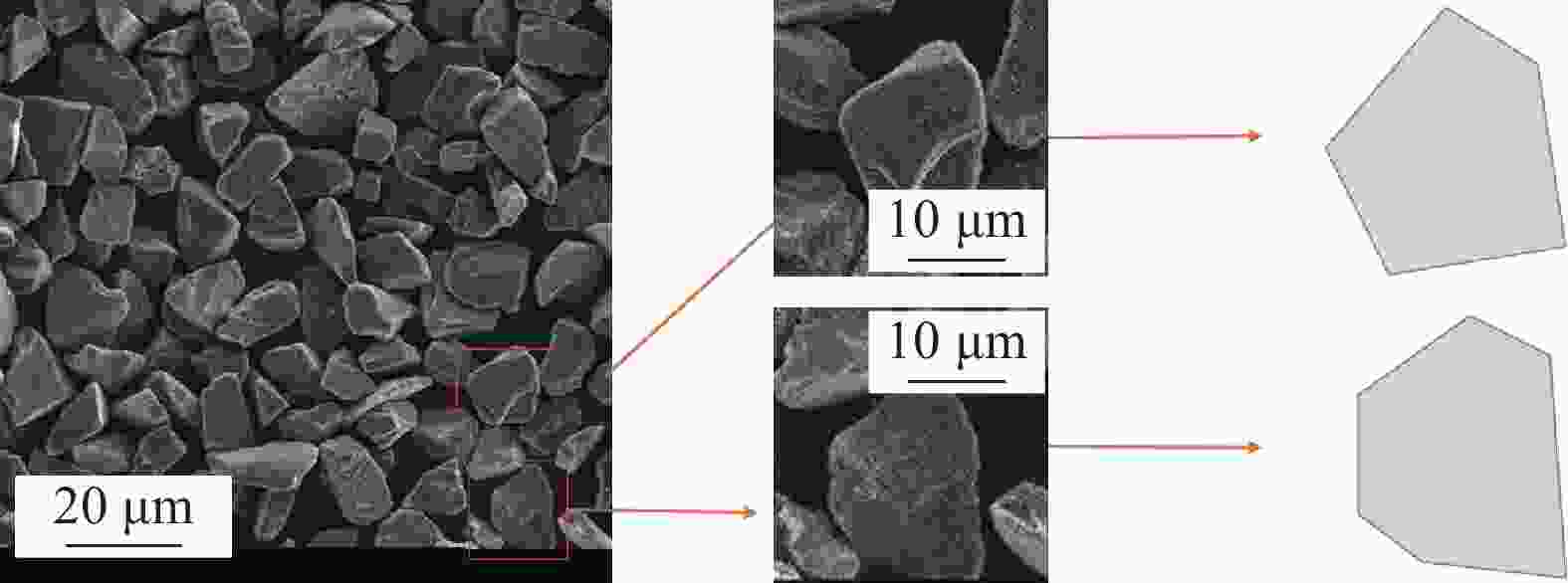
 下载:
下载:



